
Experiments — forgotten, but pretty
First of all, the author wishes to present to the reader the most ancient of his experiments. It is possible that some of this will interest you.
Radio receiver under the hood
So, we take a conventional radio receiver on batteries, set it to any wave and output the volume to the maximum. The receiver (see Fig.) Is located on a high dielectric stand, approximately in the center of the cavity of the structure, made up of several steel, cast-iron and aluminum pipes. The diameter of the inner tube is 30 cm, the height is 50 cm. From above and below all this is tightly closed now with steel plates of 50 mm, with the addition of aluminum and brass shields.
The structure is grounded.
As we conserve the receiver, the wave gets lost, and, instead of pleasant music, we hear only white noise.
According to all the provisions of physics, no external radio waves are able to break through to the oscillatory circuit of the receiver.
With the help of a simple device, a transformer and two discharge electrodes, we form an electric spark. The receiver will immediately respond with a characteristic creaking change in the tone of the noise.
What happened? After all (we will open the textbook of physics) even so-called. called the Faraday grid, incomparable with thick-walled metal screens, according to scientists, successfully absorbs the entire spectrum of radio waves.
Assumption 1. Electrons in a metal simply do not have time to synchronize their own reciprocating motion with incoming waves. But, only in this way they screen the radio wave.
Assumption 2. The receiver superheterodyne itself emits radio waves. Reflecting in a confined space, the waves constantly rebuild the oscillatory circuit. Thus, the receiver every minute runs through the entire range of settings, and is able to receive radio waves that have penetrated through the shielding screen.
Assumption 3. The electric spark and the oscillating circuit of the receiver, in this position, randomly emits radio waves, are similar to each other. Objects that have approximately the same spectrum of radiation — absorption communicate with each other in a special way, in addition to the laws of physics known to science. Changes in one object (A) are immediately responded to in another (B).

Speed and gravity. Empirical research
Imagine that you have an orange in your hand. If you find the power to throw it parallel to the surface of the Earth at a speed of 8 km. with., he will become a companion of our planet and, somewhat simplistically speaking, will lose weight.
Suppose you dropped the fruit at a rate of only a few meters per second. The effect of reducing weight again, will take place, although these changes are measured in fractions of a milligram.
Imagine now that your friend is throwing an orange back. Both of you are standing on a platform of sensitive scales. Will, for the time of this game, the system you-friend-orange, in general, easier?
The simple becomes very complex very quickly. Some additional, more obvious schemes represent that “yes.”
All physical bodies consist of a myriad of “oranges” — elementary particles. The average velocity of oscillatory motion of the latter, at twenty degrees Celsius, is about three hundred meters per second. As the temperature increases, the speed of movement increases.
So, we can expect that with a decrease in body temperature (in a closed system), its weight will increase slightly. And, with increasing T, the pressure on the support will gradually disappear.
To calculate more accurately, it is necessary to combine some formulas for bodies moving along a circle, and also the dependence of the velocity of molecules (acting here as “satellites”) on temperature. Friends, I once did all this, but after so many years from the time of the failed publication in “TM”, much has been forgotten. Try it yourself. The result, in general, is quite interesting. I myself did not conduct full-scale experiments, but I used the data, alas, to measure the body weight of a person before and after his death. The difference is about 10 grams (weight is added).
And the results of calculations, for a body weighing 80 kg, cooling down from 40 C, to 20 C, fully correspond to this.
Experiments with a flywheel unwinding to a certain speed are also known. The weight of the top is reduced.
In this case, the movement of the orange, sorry, is closed in a ring. Nothing more, in fact, does not change.
And, the results of calculations for the top-orange are quite in line with expectations.
…The next simple, complex visual construction. Space station, satellite, … a physical body, sweeping along the surface of the Earth at a speed of 8 km. from. as if lose weight. Well, an object that rushes directly to the center of the planet, from the depths of the Cosmos, let’s set it at a speed of 20 km. from. — What happens to him? Does the Earth, with its gravity, add extra speed to it? Are you sure? Well, if this body moves even with an acceleration above 9.8 m. sq. m. (acceleration of free fall) — also add speed?
There is a feeling that in the celestial mechanics everything is not so simple. Objects moving near planets with velocities are much higher than the acceleration of free fall (at a given distance from the center of mass) of the latter, practically do not obey the influence of “local” gravity.
Perhaps this phenomenon caused many of the failures of Soviet cosmonautics. For example, of the ten missiles launched with the moon, Lunokhods, only two of them reached the surface of Selena. With Mars, the situation is much worse. Most of the vehicles flew past these large celestial bodies.
American scientists are less conservative people, and among their practitioners there are those who could accept the need to amend the known laws of Newton.
…Gravitation depends on the mutual speed of interacting bodies. To some extent this position can be tried to reveal at the level of classical mechanics. But, perhaps, to clarify the details, it is better for us to plunge into the depths of quantum physics.
Rotating rotor
The Mössbauer effect… Particles frozen to the vicinity of the absolute zero of the crystals lose the opportunity to exchange quanta in the event that their mutual velocity exceeds several centimeters per second. The levels of radiation-absorption cease to coincide, and the objects simply “lose each other from view.” in a not frozen state, things interact only because the microparticles that make them constantly, fairly quickly, move. Thus, a quantum can almost always meet a particle suitable for it in the spectrum, and be absorbed by it.
Recall that the average velocity of molecules at room temperature is about 300 ms, electrons in the electron gas of metals are of the order of one hundredth of the speed of light.
All electrodynamics is based on the fact that charged particles exchange gluins, and so on. It is not entirely clear whether there are energy levels in this case, but, yes, it may be. And, therefore, the effectiveness of the interaction here also depends on the mutual velocity of the microparticles.
Therefore, if we move objects relative to each other at a speed, say, 1 km. the interaction of atomic nuclei consisting of positive protons and neutral neutrons will be violated in the first place. Lighter and faster electrons will lose only a thousandth of the total interaction, and will stay in touch with each other.
In general, the body that has acquired speed above the Earth’s surface is 1 km. with., simultaneously receives and a high negative charge. To calculate the total balance of the forces of interactions “electron-electron”, “proton-proton”, “proton-electron” is rather difficult, but, on the sly, the interaction of negative charges prevails. Consequently, a shell with such a high initial velocity will push away from the Earth — what should be taken into account in the ballistic tables.
Simultaneously with this projectile, a charge flows, a cloud of plasma is formed. This is indeed the case, according to the recollections of many eyewitnesses: this phenomenon can not be explained only by heating the air.
When an object collides with a target, an imbalance arises between the number of protons and electrons. In this case, the disc is subjected to a special action of internal forces, in the process of self-destruction, releases additional energy. Here the special attention, friends, are subject to observation and investigation of the artillery officer VV Yavorsky. The thermal energy emitted by the projectile when it hits the shield is sometimes four times the kinetic energy. In addition, with accelerated photography, it is clear that even before the projectile comes into contact with a metal screen, a flash like lightning occurs between them.
…The so-called discs or, otherwise, John Searle’s generators are known. The general meaning (exemplary first of all, in this case) is that metal discs rotating at high speed emit powerful electrical discharges, jam the radio receivers next to them and jump upwards.
The author’s own experience is not so effective. Two electric motors, located on a dielectric stand, are connected by shafts. The stators are short-circuited, i.e., essentially metal cylinders.
One of the motors is included in the network. The second motor is not connected. We measure the voltage between its body (including the stator), and the Earth.
When the rotation starts between the Earth and the motor, a voltage of 1—2V appears. When the voltage is turned off, it gradually decreases to zero.
In a simplified version, only one motor is used, and the same voltage change is measured with a deceleration of the rotation during a trip.
The meaning of what is happening. According to the above arguments, the force of interaction between the Earth’s protons and stator protons sharply decreases, while between the electrons of these two bodies remains the same. There are many nuances here, but electrons flow from the motor surface into space. The voltmeter registers the variation of the cylinder potential — although, of course, much less than in experiments with Searle disks.
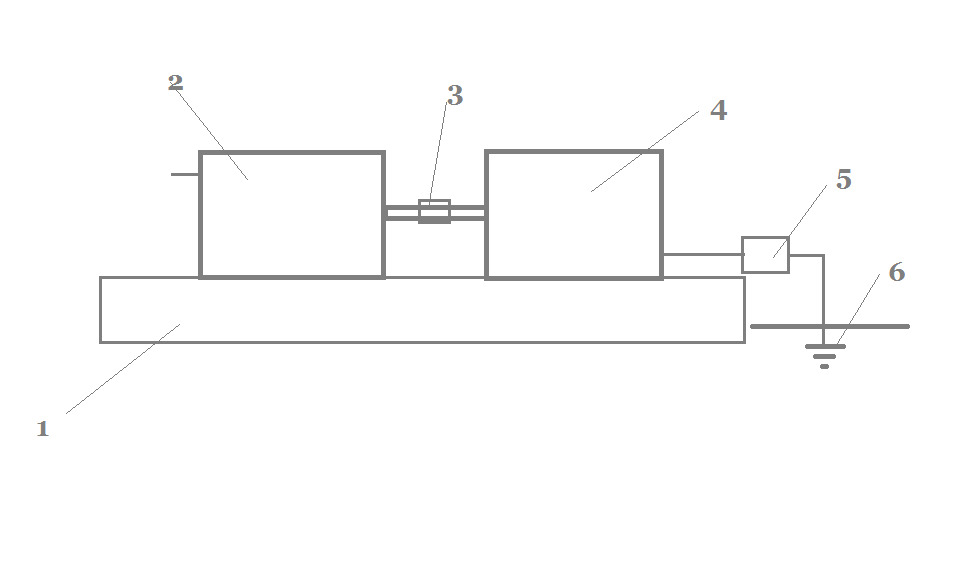
…Unfortunately, there is no picture of Generator John Searle available on the Web. The general meaning. On the stator are located magnets, defined poles to the axis. The rotor is studded with magnets with poles outwards. Everything, as if, is simple. As soon as you give the rotor a certain speed of rotation, this “disc” starts to rotate by itself.
We know that the magnetic energy is conservative. If, say, to place a magnet under the veneer, it can accelerate the steel ball located on its (horizontal) surface. But, after a certain point, this ball can not move any more. The same magnet returns it back.
But, how then, for example, does the “gravitational catapult” known in space work? A certain space station approaches, like an example, to Jupiter, is captured by its gravitational field, acquires an additional velocity of the planet’s motion around the Sun. Then it is somehow freed from the influence of the planet’s gravity and, with a gain in energy, flies to other bodies of the Solar System.
Another example is “cathode rays.” The electron flies to a charged positively plate, accelerates it, then passes, and for ever leaves. The reverse action of the anode, as if, is somewhat weaker than the primary one. If we take our example with a magnet and a ball, it would turn out that this ball would jump a magnet, lose contact with it, and roll on. If the ball (or other magnet) is fixed on the disk next to the magnet, we would get perpetual motion…
…We can try to take as an example a ram jet engine. Essentially, this is a pipe open at both ends. Inside the fuel is burnt. There is no asymmetry. Until then, it’s still no engine. The energy of the kerosene is wasted, and nothing is set in motion by the ramjet.
But, if we give this pipe a considerable speed (comparable, it seems, with half the speed of sound), an amazing asymmetry arises, and the engine produces decent traction. The analogy, of course, is doubtful, but there are not any others yet.
As we have shown above, at certain mutual speeds, physical bodies change the strength of mutual electromagnetic, electrostatic, and possibly gravitational interactions. According to the e-mail, the quantum theory of gravitation, the interaction here is also transmitted by some, subtle particles. It is unlikely that this interaction is very different from other fundamental forces. The coincidence of energy levels is important everywhere, and this is impossible at high relative velocities of interacting bodies.
Like friends, you… it’s very difficult for us to get to know… establish a strong bond with someone, if you do not drink coffee motionless, next to each other, and in a hurry, as usual, you pass by…
So. The magnet accelerates the ball. The speed becomes so great that the force of interaction decreases to a large extent… and the connection breaks. But, the speed in this case should be very significant. It can be calculated only experimentally.
The primary promotion of the disk, the speed to enable the “ramjet” is simply necessary.
Where can magnets take their energy from? Probably, from the ordered circulation of electrons around the atomic nuclei, in numerous magnetic domains-grains. The velocity of revolution of electrons along the orbitals is very high (appreciable fraction of C). Probably, electrons will go to the lower levels, emitting some radiation. In Searl’s experiments, it was as if it was constantly observed. Maybe the magnets will cool down or degauss.
All this can be revealed only by new natural (and presented to the general public) experiments.
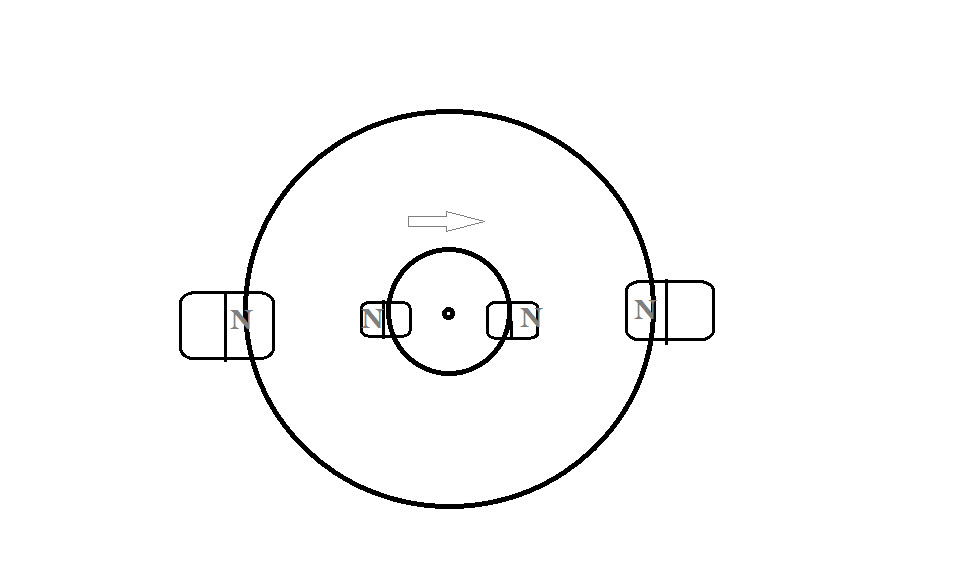
Sometimes it comes back (high quality energy)
…How to collect scattered in space, as if already falling asleep energy? Obviously, there are natural natural processes that increase its quality to its original value.
These are not some complicated devices. Everything happens by itself. You just need to be able to correctly see.
The boiled kettle on the table gives energy to the space — to the table, to the air streams, etc. As time passes, it cools down. The motion of molecules is evenly distributed in the environment. The energy of high order disappeared, replaced by a uniform thermal background. Is it possible to reverse the process? Will the impulses from the environment of the teapot be transferred in a particular case, will it boil right on your kitchen table?
This is how it should be if in nature, from the beginning of time, there is a cycle of energy.
One of the author’s first publications on this topic is an article in “TM”, No. 4, 2000:
“What is the difference between an object of the macrocosm – a monolith – from a cloud of dust obtained as a result of its long grinding and subsequent shaking? Well-known: the area of contact with the environment of another phase, for example, with gas. That is why the chemical reactions that occur in powders are completely unaffected by monoliths, iron filings burn in the air, whereas an iron nail, except in pure oxygen …
Dusty laser?
But the question is: what happens when the monolith is grinded or, conversely, how does the dust coalesce again into a monolith with a radiation-absorption spectrum? Let’s help the laws of quantum physics.
In monolith, the spectrum runs through all the energy levels, theoretically, as many as the atoms in the body. In a gas, individual atoms radiate independently, on a few levels. But when the neighboring atoms appear, the levels shift so as not to repeat each other, the prohibition principle introduced at the beginning of the 20th century works. Wolfgang Pauli: there can not be interconnected atoms, the energy parameters of which are completely the same.
But the powder is an intermediate state between the gas and the solid. Apparently, a sharp boundary, on which the properties change spasmodically, can not be carried out. And accordingly, the spectrum of the dust cloud, as the particles are fragmented, will approach the gas spectrum.
But what happens if you thicken it to the volume of the original monolith?
When merging, say, a hundred particles, each energy level will take at once one hundred atoms. To restore the order adopted in the microcosm, each of these supersaturated levels will tend to split into a hundred isolated spectral lines. The most natural way to restore the energy hierarchy for atoms of a newly formed monolith is to radiate a certain number of electromagnetic quanta. Consequently, the condensed cloud of dust will become generally colder than the surrounding environment.
Are we humans the same hubs? Than our cells are not isolated “motes” separated by membranes? But the permeability of membranes is constantly changing. And are there many unrelated properties of living organisms that are not associated with such a unification of many millions of “dust particles”?”
Continuation – in the article “Energy concentrators”, “TM” No. 6, 2002, already based on practical, not mental experiments.
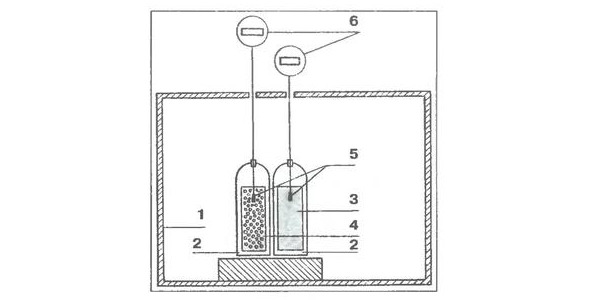
Two vessels — one with a porous medium, the other — with a solid, are located in a thermally insulated cabinet. They have thermal sensors; the temperature inside is measured every 20 minutes.
It was found out that the temperature in a container with a granulated medium (wet sand, etc.) varies abruptly, with considerable amplitude. The solid medium gives a very flat temperature graph, without bursts and any periodicity.
Porous, granular, otherwise — ordered matter has the property of ordering — to collect in space and time, energy. Probably, this property manifests itself on different scales. Local heating can also occur in a handful of sand, earth, porous clay, only one or two degrees, and in large areas, in square kilometers. The temperature can increase by tens, hundreds of degrees, possibly accompanied by radioactive emissions. So the energy of a high level comes back to the world.
In a certain way ordering matter, it is possible to achieve a predictable ejection of heat (or cold), in certain areas of the created system. Covered by feedback, the system creates a “cold-heat” pulsation; from this one can obtain a steady stream of energy. The ordering can be performed on macroscopic (fractions of a millimeter) and micro-levels (the distance between the atoms of the crystal). In the latter case, it is possible to achieve not intermittent flicker, “eternal radiance”.
In the first approximation, the concentration system looks like the organization of flows of a homogeneous, initially disconnected substance to some common point, a kind of “heart” or a quantum cavity, followed by separation.
Some successes in this, perhaps even intuitively realizing the essence of the process, were achieved by American researchers Fleischman and Pons. They are known to conduct electrolysis of heavy water on palladium electrodes. Their idea — the molecules of the hydrogen isotope accumulate in the crystal lattice of the metal, as closely as possible — and interact. As a result of the “cold nuclear fusion” (NNS), an anomalous heat release occurred (four times higher than the calculated one), but, in addition, there was no neutron radiation associated with it.
In the end, experiments — although they were reproduced in other laboratories, were abandoned, they were almost forgotten. But, with a satisfactory theory: “A structured substance structures energy, creates an order around itself,” they can be revived, put on an appropriate, correct pattern. Hydrogen atoms were collected in one small volume, and therefore they were forced to radiate (relatively soft) photons from their upper energy levels. Isotopes, the synthesis of light nuclei, radiation — this can be forgotten. New reactors of Eternal Motors are loaded with any, not radioactive, but — structured substance.
Note: A structured body (massif) is a cluster of clusters (dust grains) of a substance of equal shape, composition that is some distance from each other in a semitransparent medium or a vacuum. An additional structure in time, give periodic rendezvous and separation of particles — which is like breathing or pulse.
The author reproduced the experiments of Fleischmann and Pons at home, replacing heavy water with ordinary tap water, and palladium electrodes with sand.
It turned out this article:
Electrons get tired?
“Some of the fundamental laws of physics are so simple and obvious that no one doubts their justice, and no one is involved in their verification. In particular, this applies to Ohm’s law, according to which the direct current in the circuit (in any case at its low density) is equal to the voltage divided by the resistance: I = U / R. This is followed by other rules of electrical engineering. For example, according to the Joule-Lenz law, the heat W allocated to the resistance R is directly proportional to the voltage drop across it U, the current I and the duration of its passage t, that is W = R-U-1-t. Therefore, if two identical resistances are sequentially included in a closed circuit, then the same amount of heat should be allocated to them in a unit of time. It seems quite obvious that, bypassing the first resistance, the electrons are not able to either acquire additional energy or lose it.
But does Ohm’s law really hold for resistances of all kinds at low current densities? Interested in this issue, I performed a series of simple experiments. Two, if possible, the same resistance, I included in the DC circuit, and next to them attached sensors sensitive thermometers. Each resistance, together with its “own” sensor, was placed in a separate thermostat.
In the first experiments, as resistance, I used incandescent lamps (calculated for a voltage of 2.5 V and a current of 0.15 A). Turning on the current (its source was a reducing stabilizing transformer and a rectifier included in a household circuit with a voltage of 220 V), I measured the temperature in thermostats for an hour; then changed the lamps in places and repeated the measurements. Five series of similar experiments showed that the metallic resistances gave off the amount of heat in full accordance with the classical laws of electrical engineering, and no matter where these resistances were located.
I did not make measurements using resistances of other types, but I performed the experiment using electrolytic cells as a resistance in which ordinary tap water was decomposed on stainless steel electrodes; the result again did not reveal any anomalies.
But if electrolysis of water was carried out in a porous, heterogeneous medium, the picture turned out to be different.
I filled the electrolytic cells with a mixture of quartz sand and tap water, acidified for better electrical conductivity by several droplets of hydrochloric acid (which, generally speaking, is not necessary). And the first experiments gave amazing results, not corresponding to the classical laws of electrical engineering.
Namely, the temperature in the thermostat located in the course of the motion of the electrons turned out to be much higher than the temperature in the next thermostat! At a voltage of a current source of 220 V and its strength of 0.5 A, the difference was 90°C, which significantly exceeded the error value of previous experiments. In total I performed 10 similar experiments and noticed that the difference in temperature between cells clearly depends on the current strength in the circuit and can reach even a few tens of degrees.
I also noticed that on the first cell the voltage drop was higher than the second one (150 and 70 V, respectively), which explains the increased heat release. But the main question remained without an answer: why is there such a noticeable asymmetry, if before and after the experiments the resistance of the cells were the same? After all, this effect should not be!
It can be assumed that in the first cell the electrons for some reason lose some of their internal energy and therefore in the second cell they are no longer able to interact with ions as intensively. But in fact the second cell too (though not style strongly) heats up. True, in the sand-water electrolytic cells there are many local and rather sharp differences in the resistance of the medium, as a result of which the electrons in it are sharply accelerated, then they are sharply slowed down. Is not this the reason for the effect that I observed?
Of course, my assumption that after passing a certain device, the electrons can seem to get tired, giving the environment some special energy, contradicts the laws of nuclear physics, according to which the electron does not have an internal structure and has only a reserve of external kinetic energy. But if I’m wrong, then let me point out the error, preferably by repeating my experiments.
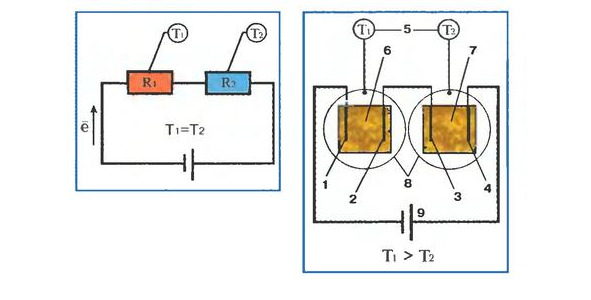

…The original idea of the experiment is an anomalous heat release in a granular medium. It turned out not quite what was supposed to be found, but still, the result is interesting. It looks as if the charge carrier, ions and electrons, interacting tightly with each other in the first cell along the current, lose some of their internal energy. Or else, this energy is allocated. And, of course, all this happens in an internally divided, more or less ordered environment.
Unfortunately, the lack of calorimeters, tools for accurate determination of the amount of heat released does not allow to receive data at a quantitative level. But the qualitative result is also a good result.
…In the first approximation, the electromagnetic energy generator can look like a slurry of magnetic microscopic balls in an external medium. According to all the above, the ordered array should periodically change its properties (and hence the magnetic flux) in time. It remains to add to it a coil with a wire to get a more or less perpetual generator.
In the case of a teapot, things are as follows. Let the table on which it is left to cool — a highly ordered structure of many identical elements, in a closed volume (it can be large). The energy of boiling water is first distributed throughout the volume. Then, macroscopic temperature fluctuations will arise in the system. The period of their appearance in this or that place can be calculated or even organized. We put the cooled vessel at the right time in the right place — and it boils.
This structure can work in an open space, attracting the energy scattered in the medium, raising it to the previous high level.
To such systems, undoubtedly, one can class living beings, beginning with the simplest unicellular ones. The body consists of billions, trillions of pores, membranes opening and closing in accordance with a certain rhythm. For its life, the body attracts more energy than it consumes when digesting food, which is proved by some scientific studies. Obviously, living, ordered matter is a kind of perpetual motion machine — however, not quite perfect yet. At the very least, food is needed for metabolism, cell replacement, and the like.
High orderliness is possessed by forest massifs, crops of crops, ice cover, possibly, deserts and dried salt lakes. Here, first of all, it is necessary to look for anomalous heat releases, and even radiation.
The energy (thermal, electromagnetic) that passes through the massif of matter evenly brings order into it. A standard example is the Benard cells, hexagonal honeycombs emerging in the oil layer on the heated surface. Thus, systems reanimating energy can be created, including a melt, from a solidification, under conditions of thermal energy inhomogeneity.
Metal laser
In the 90 years of the last century, a wide resonance in the near-scientific community received experiments (that’s funny) with electromagnetic resonance. The researchers claimed that they receive “Energy from nowhere”. Here, first of all, the resonance generator AV Chernetsky (although outside of Russia, in America and Europe, this principle of obtaining additional energy is patented).
Basic meaning. The electric oscillatory circuit is made up of a capacitor, an arrester (two facing electrodes), and also loads — usually incandescent lamps. A pulsating voltage is applied to the circuit from the transformer. The electric arc is ignited. At the same time, the lamp flashes. Electricity meters show that the load is more powerful than the one that is connected to the oscillatory circuit.
The explanations of the author of the experiment, and also of the majority of forum participants devoted to alternative energy (apart from critics of energy meters) — “The electric discharge draws virtual particles from the vacuum, and therefore enhances the flow of electrons.”
Is this statement too broad, friends? Let’s try to understand the issue without attracting new and new unknown factors to it.
…If we “straighten out” the electrical circuit, we will get a piece of wire with condenser plates at the ends. All this strongly resembles the image of a classical optical laser (or, in the Soviet way, an “optical quantum generator, a laser.” The conductor in this case is a laser body, an analog of a ruby rod. The capacitor plates reflecting the electron beam are optical mirrors.
In a conventional laser, by external pumping, or in some other way, an overpopulation of the energy levels is achieved. Quanta of a certain energy cause a cascade of stimulated emission events. The light stream formed in this way resonates between the mirrors, and, at a certain moment, breaks out.
We can well assume that the metallic conductor also has a multitude of microparticles (ions, electrons) that have the same energy level. And, when an initiating burst of voltage passes through it, it is able to form an additional, respectively directed flux of electromagnetic quanta and (or) electrons.
Thus, “energy from nowhere” can arise.
But, for all that, the working body of such a metal laser must have a certain time for natural relaxation of the energy levels. In other words, with the passage of time the output of additional electricity will decrease to zero. It is this inconsistent result, perhaps, that has reduced the intensity of interest in “Eternal Motors” on the basis of resonance.
An increase in the effect is possible provided that conductors with a developed surface are created, granulated, internally separated, into zones with the possibility of maintaining the same spectrum, or alternating.
Recall that in experiments on the scheme given in the article “Electrons get tired?”, After several long experiments, the anomalous heat release in the first-in-the-way current of a container with moist sand also ceased.
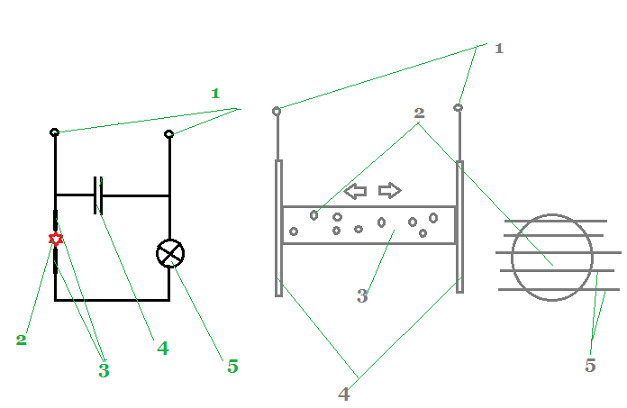
Oddities in a glass jar
An interesting long-standing experiment is the detection of an anomalous attractive force between two plane-parallel plates (in the air).
The so-called Casimir effect is known. Two metal plates, when approaching each other for a distance of thousandths of a millimeter, experience attraction. The explanation of this effect is quantum fluctuations. It turns out that virtual particles can not appear between the plates, whose wavelength does not fit a multiple of the times between the plates of such a resonator.
In this case, in the volume of torsion scales (the basis of which is a glass jar), tangible traction to each other is tested by plates made of any material — plastic, cardboard, metal, etc., the distance between the planes is about four centimeters.
Lighting, even the cold light of a gas discharge lamp, increases the force of attraction.
Earthing of the whole device does not give any result. Static charges have nothing to do with it.
Probably, this phenomenon would have been noticed much earlier, for example, in preparation for the study of the Casimir effect. Presumably, it does not appear in a vacuum. But, nevertheless, the fact that he works in the air environment is also interesting.
Let me also mention (to the point whether?) That in the rubric, something like “Household Phenomena” of the highly respected Discovery Channel, it is discussed for a long time why in the bathroom, your body stubbornly drags along, and the wet curtain sticks. A single answer was never found. Probably, the presented effect has the same nature.
Assumption 1. The air in the space between the plates abruptly cools down, or heats up. In both cases a convective gas motion will occur and, according to the known laws of hydrodynamics, the plates will approach. So, by the way, “ships” are experiencing “mutual attraction”.
But, why is there such a sudden change in temperature?
Assumption 2. Close-lying plates (even non-magnetic ones) are connected by lines of force and structure the space. More ordered air is compressed or expanded — we do not know exactly what it is, and causes the plates to move.
Assumption 3 (consistent with 1). The space between the plates is the place where the interaction between air molecules (gas mixtures) having the same spectrum is most likely. Microparticles discharge photons from orbitals due to resonant quantum induction, a temperature change occurs. The air is moving. Plates act as a primitive resonator. The last assumption is interesting because then, it turns out, any two parallel surfaces (tubes, granules) organize an almost uninterrupted vortex. Yes, friends, two parallel plates that are reduced to a comparatively small distance – this is a miniature, simple Eternal Engine.
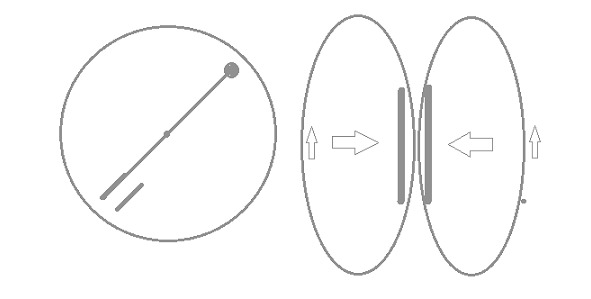
Search for order
One of the oldest, but also interesting experiments is the search for orderliness in various physical bodies or processes. According to the principle of Pauli, all matters are internally divided. For example, one atom can not have more than one electron in its composition with certain characteristics. One atom? And the molecule? A biological molecule, with an atomic weight of billions of units? Dust, already discernible to the naked eye? An object that you can weigh in your hand? This science is silent about this. In essence, intuitively representable, any body (first of all, symmetric to itself) is divided into itself into two, and more parts, so that each of these parts has its own, a particular set of energy levels.
1. One of the experiments is the transmission of an electric current through a nichrome or nickel wire. The initial assumption is that such an elongated object as a wire should spontaneously be internally divided into segments with a certain set of energy levels, and possess a pronounced periodic structure. Identify such properties can for example, by observing changes in resistance to electric current.
The course of experience. The nickel wire (from the hot plate) is straightened on the 1 meter section. To reduce the heat release to the level required in the experiment, it is possible to use lat — or simply add one more nickel coil in series. Straightened wire is stretched between two tripods.
The thermosensitive paper from the fax bends in half and is laid on the wire.
The voltage is about 140 V, the current strength is 1 — 1.5A.
After the power is turned on, the wire heats up. Thermal paper detects that the heat is uneven. Areas of stronger heat release, 4—6 cm long, alternate with approximately the same, relatively cold zones.
The current can be constant, variable or pulsating — the effect of this is not on the location of the heating zones.
2. We change the nichrome wire to the trough with acidified, for better electrical conductivity, wet sand. Will ordering appear in this environment that does not have an internal structure?
The length of the gutter is 1.2 m, the width is 4 cm, the layer of sand is 2 cm. Voltage 220 V, AC or DC.
In this case, quite obvious (the sand dries), the increased heating occurs exactly in the middle of the tank. We can say that this physical body divides this boundary into two parts.
3. Cut out a strip of galvanized sheet metal, 1 cm wide, 40 cm long. We carefully remove the oil film from its surface, all the impurities. We dispose in a burette with a solution of hydrochloric acid.
Option — wrap the strip moistened in acid with a cloth.
According to our assumptions, the process of interaction of metal (zinc) with acid should occur faster in certain places of the strip. We can not imagine all the subtleties of the process, the interaction of the energy levels of a metal and an acid, etc. A qualitative result, the periodicity, is important, at least.
…Usually, the strips are divided into three parts, two zones with increased oxidation of zinc. In some cases — in two, one central zone. A certain instability of experiments leads to confusion.
Experiments were also carried out with a galvanized strip in a transparent plastic tube, through which acid was pumped. The assumption that, precisely, the directed flow of the active liquid will form, or exhibit some special zones of corrosion on the plate, was not justified.
The variant of experiments with acid and zinc is a strip of dense tissue, 4 cm by 80 cm, impregnated in a solution of hyposulfite, and evenly spread over the gutter. In approximately 70% of cases, the strip is divided in exactly two. In one of these parts the crystals manifest themselves in full. In the other half, there are no crystals of hyposulfite at all, or they have completely different shapes and sizes.
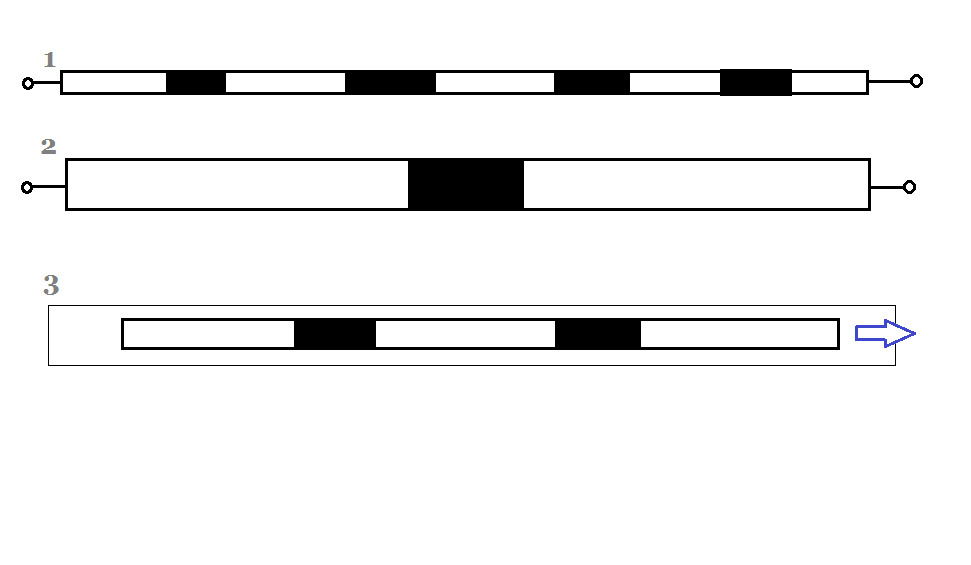
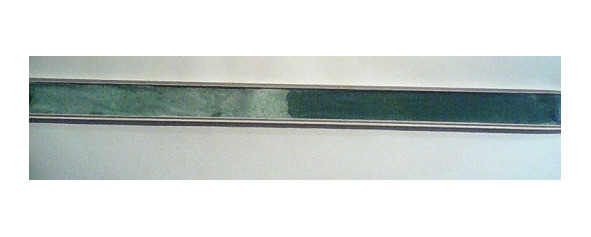
…For the sake of fairness, it should be pointed out that experiments similar to the author’s experiments, with a nickel wire from an electric hot plate, and paper from a fax, were conducted by other people.
Discussions continue around the observations of VV Yavorsky, an academician of the Academy of Missile and Artillery Sciences, who revealed anomalous heat release of projectiles that fell into the target (with calorimeter). Academicians of the Russian Academy of Sciences, of course, explain the “Energy from Nowhere” incompetence of experimenters, the combustion of dispersed metal particles and other factors. However, there are also scientists who decided to test all this experimentally (and not just a compilation of texts on the Internet and physics textbooks, to the measured buzz of an air conditioner in the office). And, if possible, they want to receive such a remarkable increase in energy in some kind of peaceful conditions.
…“The metal explodes!”
Extract from the article of Dr.Sci. Tech. M.Marakhtanov, professor MSTU. NE Bauman and A. Marakhtanov, graduate student of the University of California, Berkeley (USA).
…“When an electric current of low density flows through the wire, its value remains the same over the entire length of the wire and it heats evenly. But when the current density reaches a very large value, the flow of electrons due to quantum processes in the crystal lattice turns into a wave packet. The current strength in different places of the wire becomes different, and the metal grouped into the wave by electrons is heated unevenly. The diagram shows that the “cold” areas with a temperature of 350–420°C and incandescent to 1050–1250°C are adjacent to the wire.
This unique frame of the video demonstrates a macroscopic manifestation of quantum processes — the occurrence of periodic temperature fluctuations of metal along a steel wire 0.3 mm in diameter during the flow of an electric current of 48.6 A across it. The wire is immersed in water, the length of its visible section is 25 mm. The wave deformation of the surface of the lacquer layer clearly demonstrates the redistribution of the concentration of free electrons in thin metallic films.”
…So, we can object to the distinguished professor: metal conductors exhibit unevenness when heated by an electric current, starting from just 1 ampere. Thus, the temperature of the wire in the hottest zones does not exceed 120 C. Thus, the “current density of a very large value” is hardly responsible for the formation of a certain “wave packet”, by means of certain “quantum processes in the crystal lattice” not indicated by the author. Do you know the parable about the man who explained everything around with the single word “Electricity” — and was considered to be a deep erudite around? It seems that in our time scientists tend to explain the majority of incomprehensible phenomena with the expressions “wave pack”, “quantum process” — without explaining, with figures, formulas, visual representations and additional experiments, what they really want to convey to us.
Our assumption – yes, according to (quite proven, and clearly presented) the principle of V. Pauli, all physical bodies are necessarily separated in themselves. So terrestrial land is divided into countries, states – to regions, administrative districts, municipalities, house management and individual dwellings. In each of these segments – its own specificity, somewhat different organization of interaction with the environment. And, at the same time, under normal conditions, segments … or, organs, cells of a physical body (let us imagine a long-standing analogy) are practically not distinguished.
And again the bands
We all know the long experience, usually conducted in physics lessons. A permanent magnet is placed under a solid sheet of paper. Iron sawdust is poured from above, and the cardboard is shaken slightly. In a brief moment of the state of weightlessness, jumping sawdust gets rid of frictional forces, and get the opportunity to settle on the lines of force of the magnet.
So the field becomes visible.
But, do not magnetic bodies have their own special force fields? Let’s try to use the old proven method for clarifying this issue.
We put a sheet of paper on the table. Around the center we have a massive bar — made of plastic, wood, copper, aluminum, and so on. Then, from a height of about 70 centimeters as far as possible, evenly, we sow metal sawdust or sand over the entire surface of the sheet. The material of sawdust in general is not important. It is important only that the smallest grains do not have a round shape. So, for example, round particles of quartz sand as a “developer” of the field are not suitable.
There is such a picture. On the axis of the bar, sawdust draws a fairly dense central band. The screen, any barrier is not an obstacle for this line of force.
Along the bar, parallel to the central line are other, similar, but less dense lines (A). The frequency of their repetition, with the distance from the bar, decreases.
There are also lines (B) perpendicular to the central axis of the bar.
Sometimes the lines A, along with their perpendicular B, deviate from the central axis by about twenty to twenty-five degrees.
So, being in a state of weightlessness, during flight to the surface of the sheet, elongated grains are oriented in space by some unknown force fields. Turning grains, as well as their thickening, show lines of force. Electromagnetism, magnetism and electrostatics have only an indirect relation to this phenomenon.
We arrange two massive rectangular bars on the sheet parallel to each other and at a short distance (10—12 cm) (see the figure below). We now carry out the well-known procedure for revealing the field. It turns out that there is a thickening of the lines of force between these objects. Usually, the space between the bars is divided by lines (parallel to the inner surfaces) into three equal parts. Sometimes these parts are two.
…We can recall the so-called geobiological lines of the Earth — a phenomenon that has already almost reached the rank of phenomena studied by academic science. Authoritative enough scientist, physician Ernst Hartmann is the discoverer (1960) of the lines covering the whole surface of the earth, parallel and perpendicular to the meridians. The average size of the cells is 2 by 2.5 meters, but there are only 0.5 m cells.
Characteristics of the so-called. “Hartman’s grid” depends on the terrain, the location of buildings, and other factors. It was also noted that the cell size changes cyclically throughout the day.
The way to identify the grid lines, unfortunately, is still not completely learned. It is a frame or pendulum in the hands of a particularly sensitive human operator.
There is also a network of Z. Wittmann, 16 by 16 meters and F. Peiro, 4 by 4 meters. Quite complex, consisting of lines of different orders, the M. Curry network is diagonal to the Hartmann grid.
We can assume that, in the first approximation, the “sawdust method” can play the role of at least some kind of physical tool for detecting such fields.
Option — the use as indicators of microbial culture in broad burettes, impartial plants, or germinating seeds.
I believe that these studies can provide very valuable knowledge about the structure of bodies (formed, for example, by spontaneous separation according to the principle of Pauli), their remote interaction, and so on.
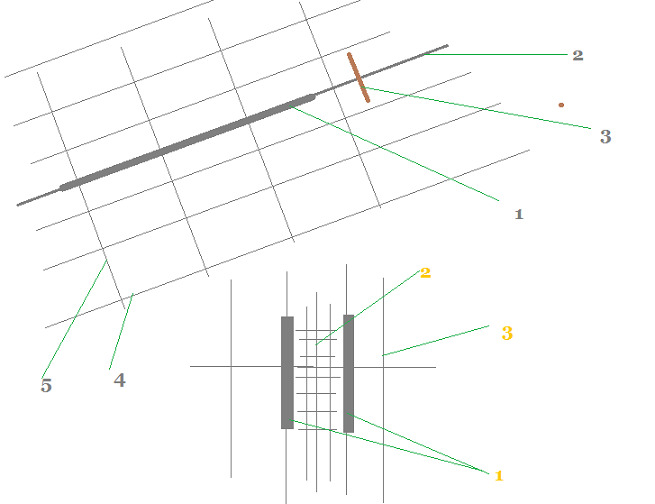
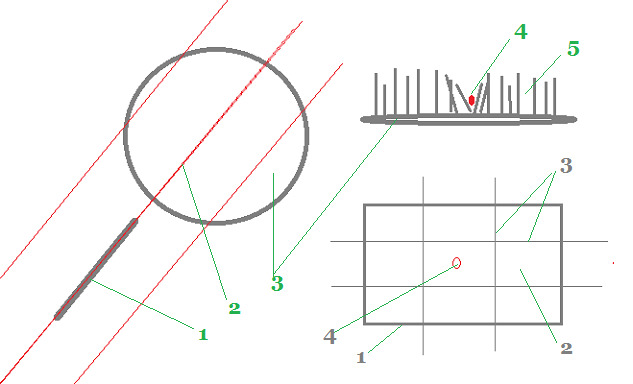
Interaction of similar forms
It is intuitively clear that two identical objects are linked in some way; Further on this inner conviction layered the well-known physical formulas and principles.
Any physical body has a strictly set of levels of absorption-radiation of electromagnetic waves. The location of power rails is affected by the structure, shape, chemical composition, temperature, etc. In other words — the spectrum, in its entirety — this is the name of the thing, the set of drawings, the code.
What will happen if, in a closed volume, two identical things are located next to each other? They will start exchanging radiation. The system will tend to come to a stable equilibrium. But, this is possible when the lines of the spectra of both bodies coincide, like the water levels in the communicating vessels.
In other words, the spectrum of the body A will tend to impose itself on the body B, and vice versa.
Electromagnetic radiation is not purely informational, it has a certain power component. If the bodies A and B (at least one of them) are sufficiently plastic, they will tend to change — in the direction of maximum mutual similarity.
Here, presumably, at a macroscopic level, Pauli’s principle (prohibition) can come into force — two objects can not be (nearby, in the same system) at a single energy level. Thus, around the body A there are concentric zones in which its action on B will be destructive, or creative. The likeness of A and B depends on exactly how far apart they are separated. It is possible to determine this distance only empirically (ie, experimentally).
We will refer to the act of additional assimilation by exchanging our own radiations — Synchronization. As a result, we get two physical bodies, each of which has microparticles having their reflection, a synchronized pair, in another object. And, these particles interact by exchanging electromagnetic quanta (and, perhaps, somehow in some other way).
Here, the Heisenberg uncertainty relation (principle) comes into play. Roughly speaking, two microparticles in a relatively small region, having the same parameters, become paradoxically connected in some way. Some changes in the particle A are transmitted to the partner B, instantly, and, as the founders of quantum mechanics claim, in a non-physical way (ie, without the participation of any waves or particles). A and B are considered as a single system, even if the parts are in different parts of the universe.
It turns out, after the primary synchronization, the macroscopic bodies A and B, made up of myriads of microscopic a and b, feel each other’s changes. There are various schools of quantum mechanics, some of them try to observe the principles of the Theory of Relativity (the finiteness of the speed of light). But it seems that we have a communication system in which the signals are transmitted many times higher than the “constant” C (300 000 km s).
In the first experiments, I used two identical containers A and B. In the first I put a simple small addition — a figure of a triangle, a square, a pentagon… In both tanks I poured a hot solution of hyposulfite, placed them side by side in a thermally insulated box, and waited for the crystals to show. The solidifying solution is the desired plastic body, sensitive to internal and external influences.
In many cases, the crystals actually appeared on the surface of the solution, formed a kind of label. But, with each time such experiments were reproduced worse and worse, coming to naught usually, to the fourth repetition. This is not quite what modern science requires – experience must be reproduced every time, with accurate reproduction of all conditions, in any laboratory in the world. And of course, the article on such tests is quite serious publications will not take. In the end, the material – just to have something in print – was published in the journal “Young Technician”, 2013, No. 5, under the heading “Mad Ideas”.
Experiments with similar forms
…“We are used to the fact that only living organisms have the ability to learn. But can such a property boast chemical compounds? Our long-time author… believes that it is possible and such. That they seem to confirm the experiments they have set.
Take two identical containers — for example, plates or photocells, if any. Mix the alabaster on the solution of hyposulfite (photophyxis). The resultant slowly set the mixture in the same portions on plates. Then put on the surface of one of the plates a mark — carved from plastic or wood triangle. Place the tanks at a distance of one meter from each other, and to protect against external influences, you can cover them with something, for example, with the same plates.
As the mixture solidifies, fine white crystallites of hyposulfite appear on its surface. In this case, the hyposulfite crystals in the second plate formed, as the author claims, the contours of the triangle, copying the triangular spots that appeared in the first form around the real triangle.
“Three experiments in a row showed approximately one result,” the author emphasizes.
Бесплатный фрагмент закончился.
Купите книгу, чтобы продолжить чтение.
